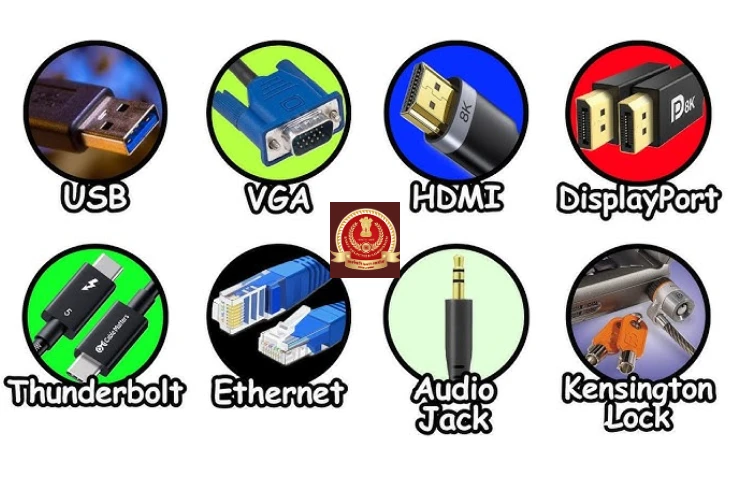Computer ports are important in Computer Awareness for SSC CGL Tier 2 exam. They act as communication gateways through which data is transferred between the computer and external devices. Understanding ports helps you answer technical MCQs in exams.
What are Computer Ports?
A port is a physical or virtual connection point on a computer that allows external devices (like keyboard, mouse, printer, or pen drive) to communicate with the CPU. Ports can be hardware-based (like USB, HDMI) or software-based (like port numbers in networking).
Types of Computer Ports
The major types of ports that are given in the table below:
| Port Type | Full Name | Main Use | Key Features |
| USB | Universal Serial Bus | Connect pen drives, keyboards, external HDDs | High speed, plug-and-play, versions: USB 1.0, 2.0, 3.0, USB-C |
| HDMI | High-Definition Multimedia Interface | Connect monitors, TVs, projectors | Transmits high-quality audio & video |
| Ethernet | RJ-45 | Wired internet connection | Looks like a wider telephone jack |
| VGA | Video Graphics Array | Connect monitors | Only video signals, older port |
| Audio | – | Speakers, microphones, headphones | Color-coded: Green – audio out, Pink – mic input |
| PS/2 | – | Connect keyboard & mouse | Old port, mostly replaced by USB |
| Serial | COM Port | Connect modems, older devices | Transmits data one bit at a time |
| Parallel | LPT Port | Connect printers, scanners | Transmits multiple bits at once |
| Thunderbolt | – | Modern laptops for multiple devices | High-speed, combines data, video & power |
Important Software (Logical) Ports in Networking
Apart from physical ports, networking also uses software-based ports (numbered). These are logical endpoints for communication. Common ones:
| Port Number | Service/Protocol |
| 20, 21 | FTP (File Transfer Protocol) |
| 22 | SSH (Secure Shell) |
| 25 | SMTP (Email sending) |
| 53 | DNS (Domain Name System) |
| 80 | HTTP (Web browsing) |
| 443 | HTTPS (Secure browsing) |
Also check out: SSC CGL Typing Test Errors to minimize your errors in Data Entry Speed Test.
Why Ports are Important for SSC Exams?
In SSC exams, ports are an important topic in the Computer Awareness section, as questions related to different types of ports and their functions are frequently asked.
- Questions on USB versions, HDMI, VGA, Ethernet are frequently asked.
- Networking ports (like 80, 443, 25, 22) are common in technical awareness sections.
- Understanding ports improves your computer knowledge and exam accuracy.
Key Takeaways
Computer ports are important for both hardware and networking communication. For SSC CGL Tier 2, focus on commonly used hardware ports (USB, HDMI, Ethernet) and logical ports (80, 443, 25, etc.). Computer ports are gateways for data transfer between the CPU and external devices.
- Physical ports include USB, HDMI, VGA, Ethernet, PS/2, Serial, Parallel, and Thunderbolt.
- Each port has a specific function, like connecting storage devices, displays, or network connections.
- Logical/software ports in networking, such as 20, 21 (FTP), 22 (SSH), 25 (SMTP), 53 (DNS), 80 (HTTP), and 443 (HTTPS), are important for technical questions.
- Understanding ports helps in answering Computer Awareness questions accurately and improves overall SSC exam performance.
FAQs
A computer port is an interface or connection point that allows communication between the computer and external devices.
The main types are USB ports, HDMI, VGA, Ethernet, Audio ports, and Serial/Parallel ports.
USB ports are used to connect devices like keyboards, mice, printers, pen drives, and external hard disks.
HDMI carries both high-definition video and audio signals, while VGA only carries analog video.
The Ethernet port is used to connect a computer to a wired network for internet and LAN access.
- SSC CGL 2025 Tier 1 PYPs, Shift-Wise Previous Papers, Download PDFs
- SSC CGL Tier 2 Paper 1 Preparation Tips, Check now
- SSC CGL टॉप 5 हाई पेइंग जॉब्स कौन-सी हैं?, पूरी जानकारी यहां
- SSC CGL की तैयारी के लिए सबसे अच्छी किताबें कौन-सी हैं? यहां चेक करें
- SSC CGL पोस्ट प्रेफरेंस, SSC CGL की सबसे अच्छी पोस्ट क्या है?
- SSC CGL के लिए योग्यता क्या है? आयु सीमा, शिक्षा, शारीरिक मापदंड और अधिक

I’m Mahima Khurana, a writer with a strong passion for creating meaningful, learner-focused content especially in the field of competitive exam preparation. From authoring books and developing thousands of practice questions to crafting articles and study material, I specialize in transforming complex exam-related topics into clear, engaging, and accessible content. I have first hand experience of 5+ months in SSC Exams. Writing, for me, is not just a skill but a way to support and guide aspirants through their preparation journey one well-written explanation at a time.
